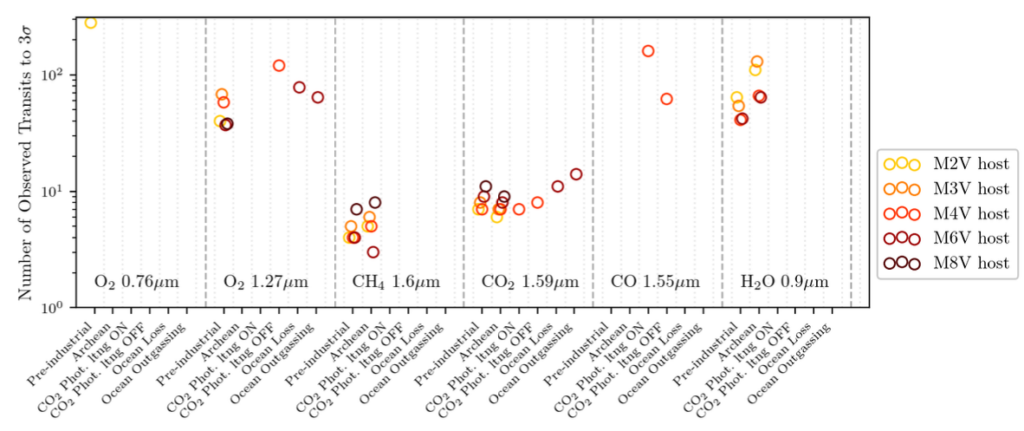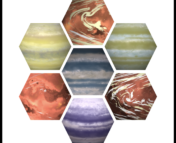Title: There’s more to life than O2: Simulating the detectability of a range of molecules for ground-based high-resolution spectroscopy of transiting terrestrial exoplanets
Authors: Miles H. Currie, Victoria S. Meadows, Kaitlin C. Rasmussen
First Author’s Institution: Department of Astronomy and Astrobiology Program, University of Washington, Seattle, Washington, USA; NASA Nexus for Exoplanet System Science, Virtual Planetary Laboratory Team, University of Washington, Seattle, Washington, USA
Status: Accepted for publication in The Planetary Science Journal [open access]
Searching for Life Elsewhere
The need for characterizing planetary atmospheres grows with the increasing number of discovered exoplanets. In the quest to find life on other planets, astronomers turn to one of the main techniques we can use to study the atmosphere of an exoplanet: transmission spectroscopy. This technique can be used if an exoplanet transits in front of its host star, meaning it passes in front of the star and it blocks part of the light that we receive from the star. If the transiting exoplanet has an atmosphere, then astronomers can use this to try to infer what the composition of the atmosphere is. This technique is promising in the search for life because we can use this to search for biosignatures, which are clues in their atmospheres that could help us determine whether life is present on these exoplanets!
On Earth, oxygen is present in our atmosphere due to the process of photosynthesis that occurs in plants, algae, and some bacteria. This process takes in carbon dioxide and produces oxygen (O2) and energy stored as a sugar. We, as human beings, breathe oxygen to live. Therefore, in our knowledge of what life is on Earth, we look for oxygen in other planets as a sign of life. However, today’s authors argue that “there’s more to life than O2” and explore what other molecules could help indicate whether life could be present on exoplanets. They also explore which of those molecules can be detected by the extremely large ground-based telescopes (ELT) including E-ELT, TMT, or GMT sized telescopes.
A Novel Detectability Pipeline
The authors in today’s paper aim to estimate how detectable different molecules can be in the atmospheres of terrestrial exoplanet atmospheres by using a technique called cross-correlation analysis (see figure 1). This technique works by comparing the simulated transmission spectra put in at the beginning of the pipeline to a model template of the molecular absorption bands from other studies. To assess how they compare to each other, the authors use a “correlation coefficient”. Higher the value of the “correlation coefficient” means better the match between the two spectrums. For this paper, the authors chose seven molecules: O2, CH4, CO2, H2O, O3, CO and C2H6 to be studied in four main types of atmospheres. The four types of atmospheres they focused on were: pre-industrial Earth (PIE), Archean Earth (ARE), an atmosphere with an accumulation of oxygen (O2) not caused by life due to the breakdown of carbon dioxide (also known as photolysis) with both no lightning and lightning occuring. Lastly, the authors chose to study these molecules in these different types of atmospheres around five different M-dwarf stars at two different distances from the observer. This was all done through a new detectability pipeline made by the authors and can be seen in Figure 1.

What Can We See?
By using this new pipeline, the authors were able to determine which of the seven molecules is more likely to be detected with the extremely large ground-based telescopes (ELT). The best two potential biosignatures that could be discovered on terrestrial exoplanets with ELT are CO2 and CH4 followed by O2, H2O and CO. If carbon dioxide (CO2) is detected with methane (CH4), in the atmosphere of an exoplanet, the authors explain that this constitutes a “disequilibrium biosignature pair” that could be driven by life and only requires between 5 and 20 transits to be detected for their most optimistic scenario of Earth-like planets at two different distances from observer (see figure 2). Similarly, if oxygen (O2) and methane (CH4) are detected together in an exoplanet’s atmosphere, that is also another disequilibrium biosignature pair that could be driven by life. Both of these pairs could easily be acquired in as few as 39 transits for their “most optimistic scenario of an Earth-like planet transiting a star 5 pc away”. As for the other two molecules, O3 and C2H6, both are not accessible with ground-based transmission spectroscopy.

This study is an exciting step in our understanding and search of life in terrestrial exoplanets using transmission spectroscopy through extremely large ground-based telescopes. This paper demonstrates the need for these ground-based observatories and highlights how they can complement our current observations with space telescopes such as JWST. By using and studying these observations together, we are one step closer to being able to characterize these exoplanets and potentially find life.
Astrobite edited by Pranav Satheesh
Featured image credit: ESA/Hubble, M. Kornmesser




